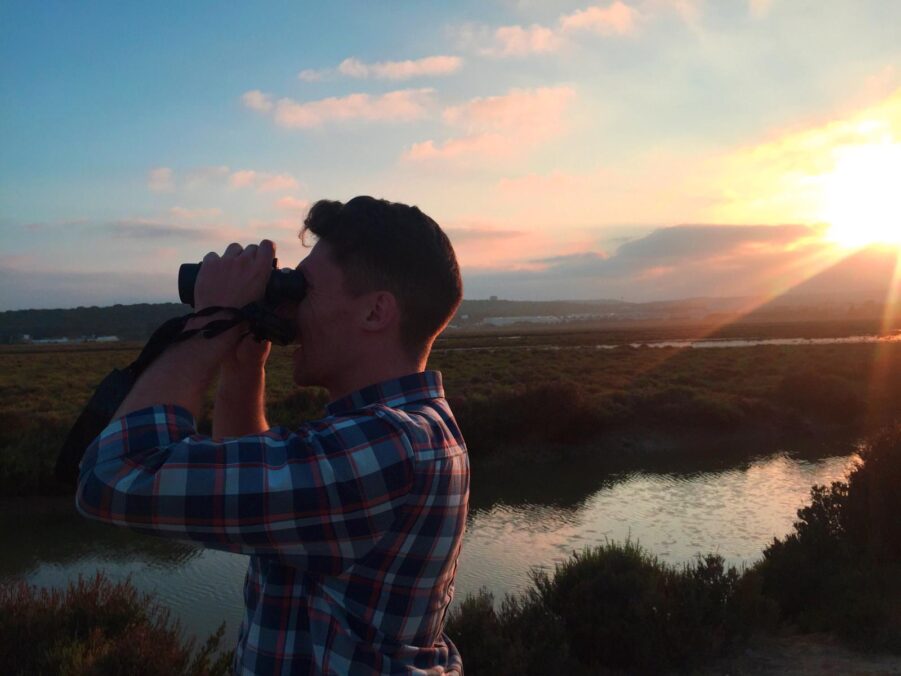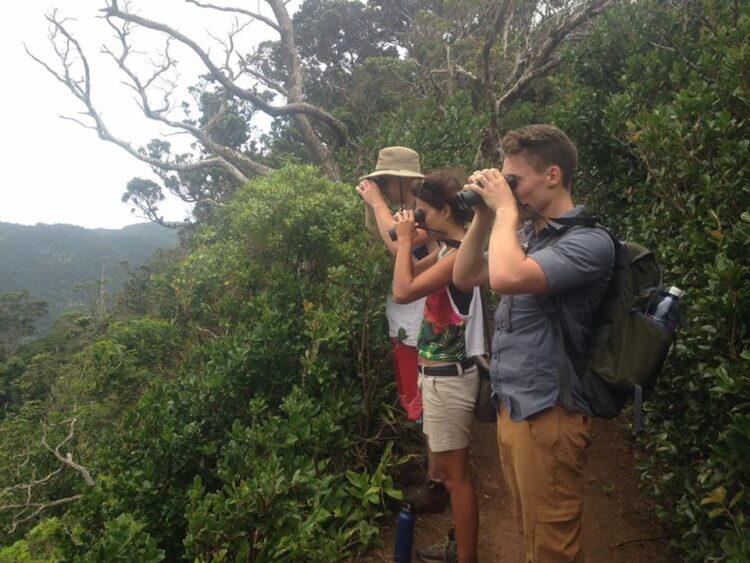
Whether or not you’re a birder, binoculars can really enhance time spent in nature. Animals are often wary of people, making it hard to see them up close. Binoculars can bring you up-close and personal with animals at medium distances, or help you find or identify things at longer distances if they are inaccessible. I’ve used my binoculars for everything from sparrows to elk and even butterflies.
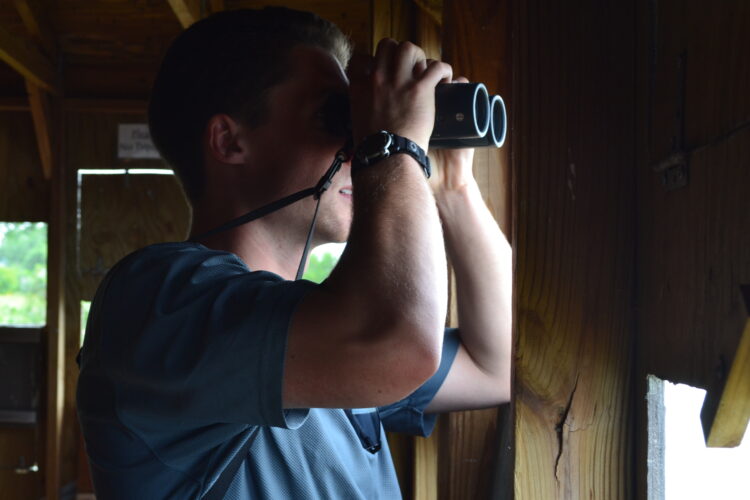
Learning to use binoculars is a key naturalist skill and makes life as a beginning birder that much easier. Even though they are well-known and often referenced in popular media and cartoons, many people have trouble using binoculars when the time comes to get a better look at something. This first post on Birdwatching Basics will introduce you to these fantastic tools and how to use them effectively.
Setting up to use binoculars
Binoculars are pretty simple, but it’s still worth getting to know their main “moving parts”. Getting a handle on these can really make them easier and faster to use. That’s especially important when you’re dealing with wildlife that tends to move quickly.
In such cases, you won’t have time to fiddle around, and need to be locked on right away or risk missing some key detail or fascinating behavior. When you’re dealing with a standard pair of binoculars, you’ll have four main adjustments:
- Eye width
- Focus
- Diopter or one-side focus
- Eye relief
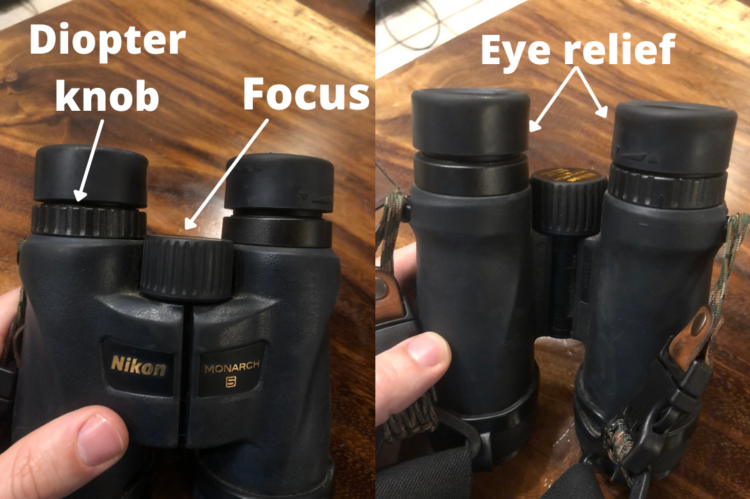
Eye width
Adjusting the eye width of the binoculars is simple—just push together or pull apart the two halves and they’ll move around a hinge joint along the center. You can do this fairly quickly, but it’s worth doing ahead of time. Try bringing your binoculars up to your eyes and check if they feel comfortable. Can you see a clear, single image from viewing through both eyes at once? If not, try adjusting the width until you see a single image. This should be a comfortable width.
Eye relief / Eye cups
Eye relief or eye cups are hollow extensions that you can pull or twist out from the eyepieces to make them fit more snugly. Since our eyes are recessed a little in our heads (our skulls have eye sockets), it can be hard to hold the eyepieces snugly to your face without eye relief. I typically use this unless I’m wearing glasses (in my case, sunglasses), when it’s better to keep them flat. Adjusting eye relief is relatively fast and won’t take up much time in the field.
Focus
The focus is probably the most intuitive and important control on a pair of binoculars. Also called the focus wheel or focus knob, this part helps you get a better image while you’re viewing something. The focus knob changes the position of the lens in both barrels at once. This in turn changes the distance at which your binoculars are focused. When viewing something through your binoculars, you will notice that only objects at a certain distance appear crisp and clear.
Objects closer to you, or further back than the object that is in focus will be increasingly blurry. If you move the focus back and forth, you will see that crispness move closer and further away. You’ll need to adjust the focus wheel every time you use binoculars, so there are no longer-lasting adjustments here and no prep is necessary.
Diopter
The diopter or one-side focus changes the focus of the lens in only one of the two barrels or halves. This allows users to adjust for their eyes having different focal points and degrees of vision. If both barrels were the same but your eyes had slightly different focus, the image coming into one of your eyes would always be a little bit blurry.
To deal with this, the diopter enables you to fix one barrel to a different focus than the other While the focus wheel moves the lenses of both barrels, the diopter makes an adjustment to only one. It is often harder to move (provides more resistance) and less prominent so that you can adjust it once for yourself and then not worry about it. Unless you’re going to be loaning your binoculars to someone else, you won’t have to worry about this after setting up the first time.
Adjusting for your eyes using the diopter
To fine-tune your binoculars for any differences in your eyes, follow the following steps:
- Find an obvious, easily-to-find object in clear view at 10-20 feet (3-6m) distance. I like to use street or informational signs for this, since I can tell how clear the letters are when I check for blurring.
- Closing the eye that is one the same side as the diopter, look at the object
- Adjust the focus using the focus kneel until the image of the object becomes clear and crisp. Make sure it is not blurry
- Close the first eye and open the other eye. Check whether the image appears blurry at all.
- If you’re not sure, switch back and forth between your two eyes, always keeping one closed, and compare the clarity between the two.
- If you see that the diopter-side eye is not perfectly crisp, adjust the diopter knob until that image is also clear and well-focused.
Don’t miss it! How to use binoculars like a pro
It’s not as easy as it seems to use binoculars effectively or quickly. In the process of enlarging whatever you’re looking at, they also restrict your field of view. This gives you only a small window through which to see the world. That makes it easy to get “lost” in minutiae, and a challenge to find your target.
When I take people out in nature, they often know how to use binoculars until I hand them a pair and point at something exciting. Then they are delayed precious moments trying to find something that may be obvious to the naked eye, but hidden in their zoomed-in world. To avoid running into that problem, try this simple method.
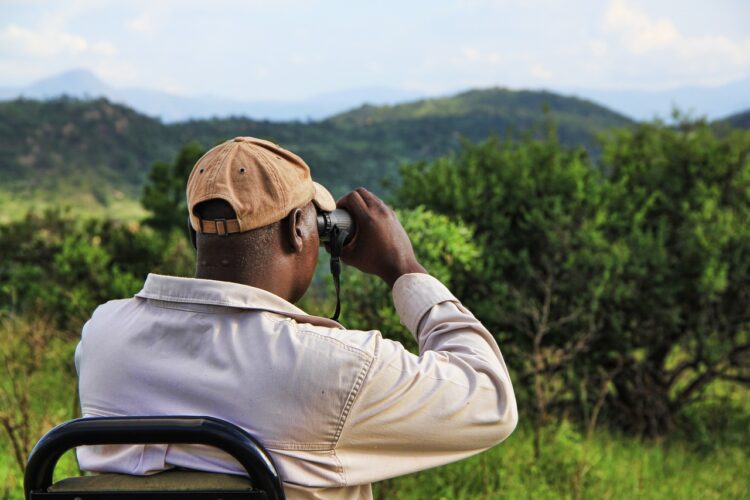
How to use binoculars: the line of sight technique
Let’s say you see a beautiful orange butterfly perched on a treetrunk a few yards or meters away. If you approach it too closely, you may risk scaring it away. But you’d love to have a closer look. Luckily, you’ve got your binoculars! You raise them to your eyes, but all you can find are other treetrunks, or branches in the canopy. When you lower the binoculars from your eyes, the butterfly is right there. it hasn’t moved! But how to get a good look?
Try maintaining your line of sight. That is, stare straight at the butterfly with your naked eyes. Then, without moving them, raise the binoculars to your eyes. If you don’t move your eyes (which you shouldn’t!) you’ll need to line up the binoculars with your eyes. The butterfly should be in your binocular image! It’s worth lowering the binoculars and trying again even if you don’t get it right the first time.
I recommend practicing this technique on a car or chair or some other large, stationary object at the beginning. As you start to get the hang of it, you can try smaller and smaller objects. For example, a flower, or a bottlecap. You can also try placing the objects at greater distances.
Eventually, it’s worth practicing in the field. Birdfeeders and pollinator gardens can be a good place to try. Just set up a chair and try to “hit” as many birds as insects as you can. Your time will be limited while they visit the feeder or flower. Or, focus on moving individuals for an extra challenge. Before long, you’ll be primed and ready to watch wildlife wherever you use binoculars.
Thanks for reading my guide on how to use binoculars!
Do you have other advice for beginning birdwatchers? Are there other kinds of Outdoor Tips that would help you enjoy your time outside? Let me know through the Contact page or in the comments!

